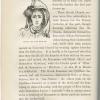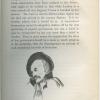Drawing of three people
Commentary
Drawings in pencil by Arthur Evans of the heads and shoulders of two women and a man, identified as portraits of a (Christian) Bosniak girl near Derventa, Bosnia and Hezegovina (bottom left), a Croat girl at Sisak, Croatia (centre), and a man from Slavonia seen at Gradiška (right).
Artist: Arthur John Evans
Date of drawing: August 1875
Continent: Europe
Geographical area: Southern Europe
Country: Bosnia and Herzegovina | Croatia
Cultural group: European Croat | European Bosnian
Format: Drawing
Size: 99 x 82 mm
Acquisition: Joan Evans. Donated August 1941
***
Exhibition caption: ‘One of a selection of drawings and ink sketches made by Arthur Evans while travelling with his brother through Bosnia and Herzegovina in the summer of 1875. They show people and places encountered by the pair on a route south from Agram (modern-day Zagreb) – via Tešanj, Sarajevo and Mostar – to Ragusa (Dubrovnik), which Evans and his wife were later to make their home. The illustrations demonstrate a particular interest in identity and dress, Evans writing, for example, of finding “two Bulgarians hard at work tying up bundles of onions, clad in their dark national costume – the brown tight-sleeved jacket embroidered with black, the dull red sash, the brown trowser-leggings which are equally Turkish and Tartar and on their head the black sheepskin cap which had at first attracted my attention.” As well as being an aide-mémoire, the drawings provided the basis for engravings published in Evans’ account of his journey, Through Bosnia and the Herzegóvina on Foot during the Insurrection, August and September 1875 (London, 1876). As an eyewitness account of a distant region in turmoil, the book was an immediate success, quoted extensively in Parliament, and it went into a second edition the following year.’ Source: ‘Travels in Finland and Bosnia-Herzegovina: An Ethnographic Collection of Sir Arthur Evans’, exhibition curated by Philip Grover, Pitt Rivers Museum, University of Oxford, 29 April to 1 September 2013.
Primary documentation: ‘[p.588] Dr. JOAN EVANS, from the property of the late SIR ARTHUR EVANS, Youlbury, Boars Hill, Oxford. [List of items follows]’; ‘[p.590] 21 Original pencil sketches, types & scenery. BALKANS’: Pitt Rivers Museum accession records (Donations X, 1937–1941), pp.588, 590. Annotations on drawing: ‘Roman Catholic/ peasant. N[ea]r Derbend [Derventa], Bosnia’ (written in pencil below drawing on left); ‘Croat/ girl./ Sissek [Sisak]’ (written in pencil beside drawing in centre); ‘Slavonian/ Gradisca [Gradiška]’ (written in pencil beside drawing on right).
Research notes: It has been identified by Philip Grover that these original drawings were used as the artwork for part of an engraving by ‘W. J. M.’ (initials of engraver) subsequently published in the British illustrated newspaper The Graphic, 9 October 1875, p.348, captioned at bottom of the page ‘4. Roman Catholic Peasant near Derbend, Bosnia. - 5. Croat Girl, Sissek. - 6. A Slavonian, Gradisca.’ Two of the same engravings were also published in Arthur J. Evans, Through Bosnia and the Herzegóvina on Foot during the Insurrection, August and September 1875 (London, 1876), p.96, printed with the caption ‘Bosniac Girl of the Possávina’, and p.85, printed with the caption ‘Head of Slavonian’. Of the former, Evans recorded in the volume: ‘About sunset we stopped at a small shed on the banks of the Ukrina, where, seated among a group of Christian peasants, we regaled ourselves with black coffee which was being dispensed at the rate of about a farthing a small cup. [...] As to the women, they were dressed in light tunics and aprons, much as Croats and Sclavonians, but their hair was often plaited like the men’s into a single pig-tail. On their head was a white kerchief arranged in a fashion peculiar to themselves, with a flower-like tassel at one side; and they usually wore in front of the two necessary aprons a superfluous black one with long fringe. Here is a Greek Christian girl that we saw at a well, and who graciously allowed us to slake our thirst from the bucket she had just drawn up’: Through Bosnia and the Herzegóvina on Foot, pp.94, 95–96. Note that Sissek is the German name for Sisak, Croatia.


